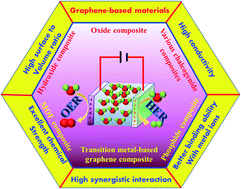Graphene-based materials as electrocatalysts for the oxygen evolution reaction: a review
Abstract
The continuous depletion of fossil fuels makes it necessary to find out an appropriate alternative energy sources to fulfill the global energy requirement. During this search, it has been observed that ‘hydrogen’ with a specific energy density value of 142 kJ mol−1 can play an important role. Electrocatalytic water splitting is one of the ways to generate pure hydrogen by forming water molecules as an impurity. Electrocatalytic water splitting consists of two half-cell reactions, i.e., the oxygen evolution reaction (OER) at the anode and hydrogen evolution reaction (HER) at the cathode. Noble metal oxides (RuO2 and IrO2) and Pt metal are considered the state-of-art electrocatalysts for the OER and HER, respectively. However, the high cost and low abundance of these noble metal-based electrocatalysts have motivated the development of alternative electrocatalysts for the practical large-scale generation of hydrogen. Recently, various derivatives of transition metals have been considered as effective and low-cost alternatives to noble metal-based electrocatalysts. However, although various transition metal-based electrocatalysts have been reported thus far to exhibit excellent OER and HER activity, their low conductivity and marginal stability under static conditions require their modification to achieve better stability. Recently, the synthesis of graphene composites with transition metal-based electrocatalysts has gain an increased attention due to their excellent conductivity and stability with excellent hydrogen generation. Here, in this review, for the first time, we have discuss the recent development of various graphene-based composites of transition metals for the water splitting reaction. In addition, the current challenges and opportunities in this field will be discussed elaborately with an extensive future outlook.



 Please wait while we load your content...
Please wait while we load your content...